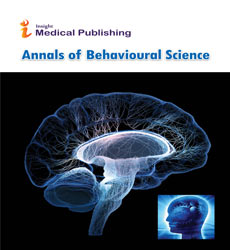Note on Psycho-Social Behaviour
Cajal Manning
Cajal Manning*
Department of Behavioural Science, Yoke University, Sendai, China
- *Corresponding Author:
- Cajal Manning
Department of Behavioural Science
Yoke University
Sendai, China
E-mail: Cajal.manning@gmail.com
Received Date: September 03, 2021; Accepted Date: September 17, 2021; Published Date: September 24, 2021
Citation: Manning C (2021) Note on Psycho-Social Behaviour. Ann Behav Sci Care Vol.7 No.3:004.
Description
People won't be fully aware of the connection between their mental and emotional wellbeing and thus the environment. It had been first commonly employed by psychologist Erik Erikson in his description of the stages of psychosocial development. Mary Richmond, pioneer of American social service regarded there to be a linear relationship between cause and effect during a diagnostic process. In 1941 Gordon Hamilton renamed the 1917 concept of "social diagnosis" as "psychosocial study". Psychosocial study was further developed by Hollis in 1964 with emphasis in treatment model. It’s contrasted with diverse psychology, which attempts to elucidate social patterns within the individual. Problems that occur in one's psychosocial functioning are often mentioned as "psychosocial dysfunction" or "psychosocial morbidity." This refers to the shortage of development or diverse atrophy of the psychosocial self, often occurring alongside other dysfunctions which can be physical, emotional, or cognitive in nature. Adolf Meyer within the late 1800s stated "We cannot understand the individual presentation of mental disease, and perpetuating factors without knowing how that person functions within the environment," psychosocial assessment stems from this concept.
Scholarly societies during this field compile researchers, academics and practitioners who have an interest in contributing to the event of this inter/trans-disciplinary field of study. There are organisations like Transcultural Psychosocial Organization United Nations diplomat for Refugees, Association for Psychosocial Studies, etc.
Psychosocial assessment considers several key areas related to psychological, biological, and social functioning and thus the supply of supports. It’s a scientific inquiry that arises from the introduction of dynamic interaction; it's an on-going process that continues throughout a treatment, and is characterized by the circularity of cause-effect/effect-cause. In assessment, the clinician/health care professional identifies the matter with the client, takes stock of the resources that are available for handling it, and considers the ways during which it would be solved from an informed hypothesis formed by data collection. This hypothesis is tentative in nature and goes through a process of elimination, refinement, or reconstruction within the sunshine of newly obtained data.
Assessment includes psychiatric, psychological and social functioning, risks posed to the individual et al., problems required to deal with from any co-morbidity, personal circumstances including family or other carers. Other factors are the person's housing, financial and occupational status, and physical needs. Assessments when categorized, it particularly includes Life history of the client that include data collection of living situation and finances, social history and supports, history , coping skills, religious/cultural factors, trauma from systemic issues or abuse and medico-legal factors (assessment of the client’s awareness of legal documents, surrogate decisionmaking, power of attorney and consent). Components include: the resource assessment of psycho-spiritual strengths; substance abuse; coping mechanisms, styles and patterns (individual, family level, workplace, and use of social support systems); sleeping pattern; needs and impacts of the matter etc. Advanced clinicians incorporate individual scales, batteries and testing instruments in their assessments.
Conclusion
The clinician’s comprehension and set of judgments about the client's situation, the assessment through a theory of each case, predicts the intervention. Hence an honest psychosocial assessment leads to an honest psychosocial intervention that aims to reduce complaints and improve functioning related to mental disorders and social problems (e.g., problems with personal relationships, work, or school) by addressing the varied psychological and social factors influencing the individual. For instance, a psychosocial intervention for an older adult client with a mental disorder might include psychotherapy and a referral to a psychiatrist while also addressing the caregiver's needs in an attempt to scale back stress for the whole family system as a way of improving the client's quality of life. Treatment for psychosocial disorders during a medical model usually only involve using drugs and talk therapy.
Open Access Journals
- Aquaculture & Veterinary Science
- Chemistry & Chemical Sciences
- Clinical Sciences
- Engineering
- General Science
- Genetics & Molecular Biology
- Health Care & Nursing
- Immunology & Microbiology
- Materials Science
- Mathematics & Physics
- Medical Sciences
- Neurology & Psychiatry
- Oncology & Cancer Science
- Pharmaceutical Sciences
